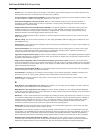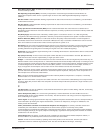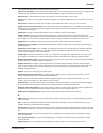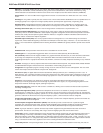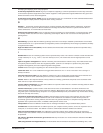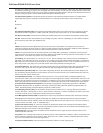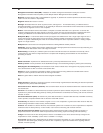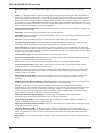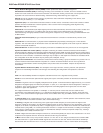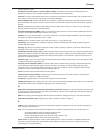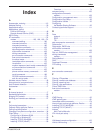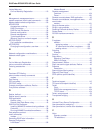
RASFinder RF300E/RF310E User Guide
RF300E/RF310E192
Out of Frame (OOF): A T1 alarm condition that is logged on the loss of 2, 3 or 4 of 5 consecutive FT framing bits.
P
Packet: 1. In data communication, a sequence of binary digits, including data and control signals, that is transmitted and
switched as a composite whole. The data, control signals and, possibly, error control information are arranged in a specific
format. 2. Synonymous with data frame. 3. In TCP/IP, the unit of data passed across the interface between the Internet
layer and the link layer. A packet includes an IP header and data. A packet can be a complete IP datagram or a fragment of
an IP diagram. 4. In X.25, a data transmission information unit. A group of data and control characters, transferred as a unit,
determined by the process of transmission. Commonly used data field lengths in packets are 128 or 256 bytes. 5. The field
structure and format defined in the CCITT X.25 recommendation.
Packet Assembler/Dissembler (PAD): Used by devices to communicate over X.25 networks by building or stripping X.25
information on or from a packet.
Packet Data: The information format (“packetized”) used for packet-mode calls.
Packet Mode: Refers to the switching of chunks of information for different users using statistical multiplexing to send them
over the same transmission facility.
Parity bit: An extra bit attached to each byte of synchronous data used to detect errors in transmission.
Permanent Virtual Circuit (PVC): A connection between two endpoints dedicated to a single user. In ISDN, PVCs are
establised by network administration and are held for as long as the user subscribes to the service.
Physical Unit (PU): The component that manages and monitors the resources (such as attached links and adjacent link
stations) associated with a node, as requested by an SSCP via an SSCP-PU session. An SSCP activates a session with the
physical unit in order to indirectly manage, through the PU, resources of the node such as attached links. This term applies
to type 2.0, type 4, and type 5 nodes only.
Point of Presence (POP): The central office’s end points of the long distance carriers.
Point-to-Point Protocol (PPP): A protocol that lets a PC user access TCP/IP (Internet memeber) using an ISDN terminal
adapter or a high-speed modem over a standard phone line.
Port: A location for input or output data exchange. Computers, muxes, etc. have ports for various purposes.
Primary Rate Interface (PRI): Used on ISDN. In North America, and Japan, PRI is one 64 Kbps D channel and 23 B
channels. Elsewhere, it is one D channel and 30 B channels.
Primitive: An abstract representation of interaction across the access points indicating that information is being passed
between the service user and the service provider. The OSI Reference Model defines four types of primitives: Request,
Indication, Response and Confirm.
Private Branch Exchange (PBX): A phone exchange located on the customer’s premises. The PBX provides a circuit
switching facility for phone extension lines within the building, and access to the public phone network. See also
“Exchange”.
PROM (Programmable Read Only Memory - pronounced “prom”): A permanent memory chip that can be programmed
or filled by the customer after by the manufacturer has set initial values. Contrast with ROM.
Protocol: 1. A set of semantic and syntactic rules that determines the behavior of functional units in achieving
communication. 2. In Open Systems Interconnection architecture, a set of semantic and syntactic rules that determine the
behavior of entities in the same layer in performing communication functions. 3. In SNA, the meanings of and the
sequencing rules for requests and responses used for managing the network, transferring data, and synchronizing the
states of network components. 4. Synonymous with line control discipline.
PSTN (Public Switched Telephone Network): A worldwide public voice telephone network that is used as a
telecommunications medium for the transmission of voice, data and other information.
Public Data Network (PDN): A packet-switched network that is available to the public for individual (“subscriber”) use.
Typically, controlled by a government or a national monopoly.
Public Switched Telephone Network (PSTN): The group of circuit-switching voice carriers, which are commonly used as
analog data communications services.
Pulse Code Modulation (PCM): 1. In data communication, variation of a digital signal to represent information; for
example, by means of pulse amplitude modulation (PAM), pulse duration modulation (PDM), or pulse position modulation
(PPM). 2. Transmissions of analog information in digital form through sampling and encoding the samples with a fixed
number of bits.
Pulse dialing: One of two methods of dialing a telephone, usually associated with rotary-dial phones. Compare with “tone
dialing”.



